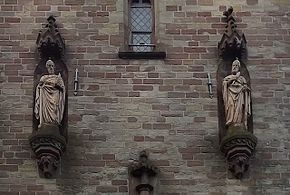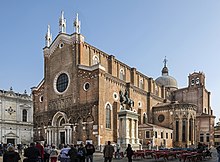John and Paul
The alleged brothers John and Paul are two early Christian martyrs and saints of the Catholic Church who are always named together. Their names are mentioned in the first prayer , the Roman mass canon . According to tradition, they suffered the martyrdom under Emperor Julian “Apostate” on June 26th between the years 361 and 363 in Rome .
Several important old churches have their patronage , including the titular church of Santi Giovanni e Paolo in Rome and the Dominican church of San Zanipolo in Venice . The evidence of her veneration goes back a long way, but the details of her biography are legendary .
Legend
According to the hagiographic tradition, John and Paul were brothers. As palace eunuchs and head of the house of Constantina , daughter of Constantine the Great , they held important offices in urban Roman society. According to another tradition, they were officers in the imperial army. In the Roman Christian community they were deacons and took part in the charitable work of Gallicanus . During the reign of Emperor Julian the Apostate , they were beheaded without a public trial for refusal to worship in their own house on the Caelius and buried there. In the 5th century, Byzantius and his son Pammachius had this house converted into a church, which today bears the title Santi Giovanni e Paolo . There relics of the two church patrons rest in two porphyry urns under the high altar. During excavations in 1575, the villa of the Martyr Brothers with an early Christian cult site from the 4th century and the two tombs of the saints are believed to have been found under the foundation walls of a small basilica.
Worship and customs
A veneration of the martyrs John and Paul is documented in Rome as early as the 6th century. Besides Rome, relics of the saints are to be found in Venice , Fulda , Vienna , Avignon , Tours and in the Minster St. Maria and Markus on the island of Reichenau .
The head relics of the two martyrs were part of the important reliquary treasure in Altenberg Cathedral , most of which was lost in the course of secularization at the beginning of the 19th century. The two relics were found in a box in the sacristy of the Church of St. Pancras during a clean-up in Odenthal in 2012 . On June 1, 2014, after more than two hundred years, the relics were transferred to Altenberg Cathedral in a new double reliquary created by the artist Heinz Mack during a high mass celebrated by Cardinal Joachim Meisner . Out of consideration for the needs of the Evangelical Church, which also uses Altenberg Cathedral, the modern double reliquary was not permanently installed in the cathedral, but is kept in the sacristy and is only shown on special occasions.
In the rural customs of the German-speaking John and Paul were for their Memorial Day, the anniversary of the death on June 26, near the summer solstice and the sleepyhead , as weather saint . The peasants called on the two martyrs against hail , storms , lightning and for or against rain and sunshine . Sometimes they were also considered the patron saints against the plague . Their feast day, the “Wetterherrentag”, was celebrated with the consecration of black weather candles , which were burned down in storms. Also were penitential processions for a good harvest held in their honor.
iconography
John and Paul are represented as Roman palace officials or knights . As attributes they carry swords , which indicate their execution , and victory palms as a sign of their blood testimony for the Christian faith and their victory over paganism . In addition, they sometimes carry a book or a scroll with them. Grain yars or clouds with rain and hail indicate their patronage as weather saints.
Individual evidence
- ↑ German in Praise of God, No. 367
- ↑ Vera Schauber, Hanns Michael Schindler: "Johannes und Paulus von Rom", in: Saints and namesake patrons in the course of the year , Augsburg 1998, pp. 316-317.
- ↑ Erhard Gorys: Lexikon der Heiligen, Munich 1997, pp. 156–157.
- ↑ http://www.altenberger-dom.de/?p=5557 , accessed on May 27, 2015.
- ↑ http://www.ksta.de/odenthal/reliquien-im-altenberger-dom-rueckkehr-von-johannes-und-paulus,15189234,27315980.html , accessed on May 27, 2015.
- ↑ http://www.rundschau-online.de/rhein-berg/reliquien-von-johannes-und--paulus-kein-platz-fuer-maertyrer-,16064474,16992820.html , accessed on May 27, 2015.
- ↑ http://www.rundschau-online.de/rhein-berg/reliquien-heilige-in-holzkiste-entdeck,16064474,27305448.html , accessed on May 27, 2015.
- ↑ http://www.express.de/koeln/spektakulaere-rueckkehr-die-maertyrer-schaedel-vom-altenberger-dom,2856,27318912.html , accessed on May 27, 2015.
- ↑ Archived copy ( memento of the original dated November 7, 2017 in the Internet Archive ) Info: The archive link was inserted automatically and has not yet been checked. Please check the original and archive link according to the instructions and then remove this notice. , accessed May 27, 2015.
- ↑ Vera Schauber and Hanns Michael Schindler: "Johannes and Paulus von Rom", in: Saints and namesake patrons in the course of the year , Augsburg 1998, pp. 316-317.
- ↑ Erhard Gorys: Lexikon der Heiligen, Munich 1997, pp. 156–157.
- ↑ Erhard Gorys: Lexikon der Heiligen, Munich 1997, pp. 156–157.
- ↑ Vera Schauber and Hanns Michael Schindler: "Johannes and Paulus von Rom", in: Saints and namesake patrons in the course of the year , Augsburg 1998, pp. 316-317.
Web links
- John and Paul in the Ecumenical Lexicon of Saints
- Entry in the Catholic Encyclopedia (English)


